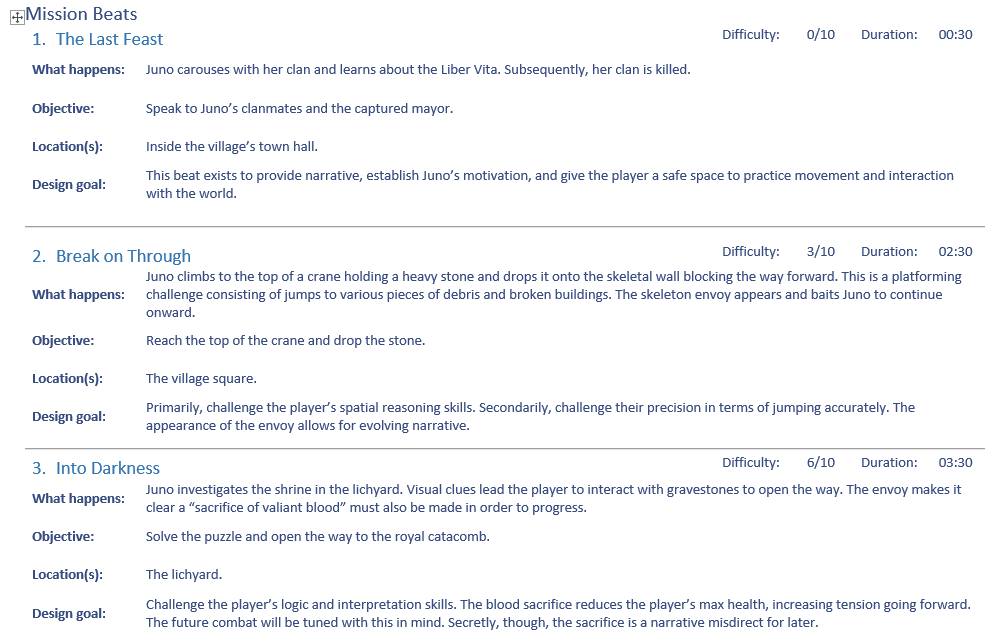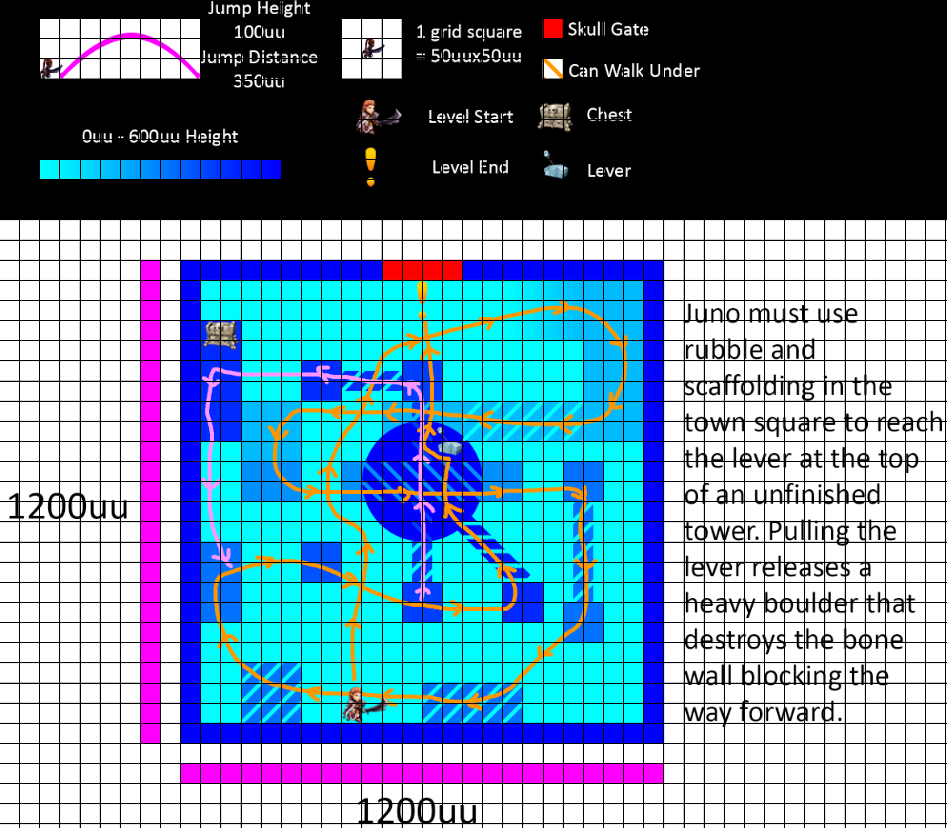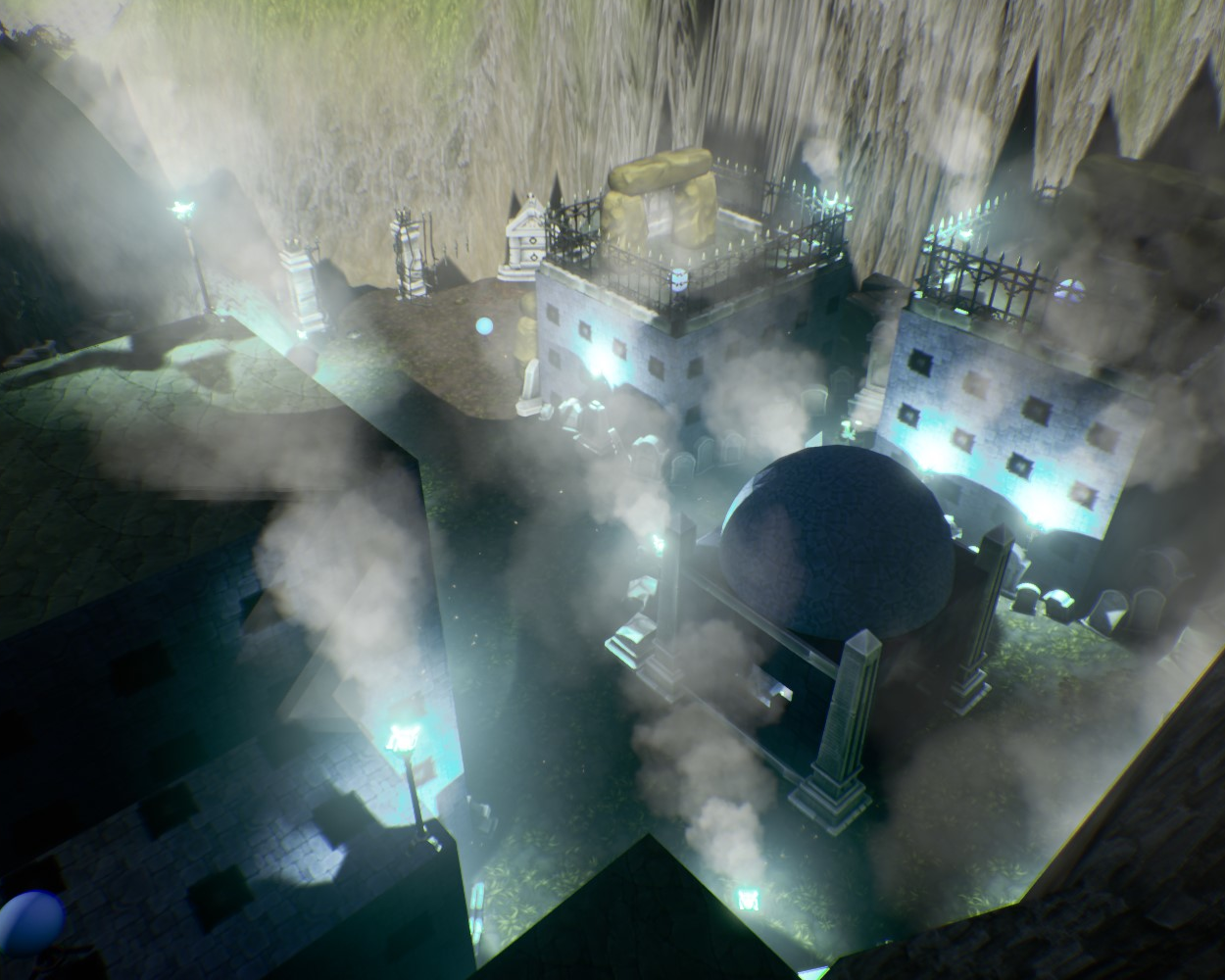
QFV: Juno’s Resurrection - Intro Cinematic
Quest for Valor: Juno’s Resurrection
QFV: Juno’s Resurrection is a third-person action platformer made in Unreal that follows Juno’s quest to revive her slain clan.
Quest for Valor is a level design student project made in UE4 that uses premade assets to assemble a series of gameplay challenges. Juno’s Resurrection is the name of the level I made for that project.
For Juno’s Resurrection, I created a level design document that included 2D layouts, beats, and puzzle design. I already knew the narrative I was shooting for and began with a loose story structure utilizing a recurring NPC to relate story and transition between areas.
Most of the AI and environmental behaviours were already present in Blueprint, but I created several unique behaviours by adding to them. The biggest two of these are a blood altar that raised out of the ground and halved the players health, and all the bosses’ attacks (except swinging his sword).
Finally, I spent extra effort on the ending cinematic using the sequencer and decided to add an additional intro cinematic as well.
If you’d like to play QFV: Juno’s Resurrection, you can find it here.
Full playthrough of QFV: Juno’s Resurrection.
Below you can find some examples of the work I did for this project:
Initial Design and Narrative
The first step to tackling this assignment was to create a level design document (LDD). I had the chance to play some previous student’s work and I knew right away I wanted to upend the idea of the player being the hero. Instead, I framed Juno as a vicious raider whose clan had just sacked the town the game takes place in. In their greed, they pillaged a sacred tome that was binding the terrible Skeleton King in his tomb. Juno then goes on an ill-fated journey to save her clan while being manipulated by the King’s envoy.
The LDD detailed the basic beats I wanted to hit as well as incorporated the images I had gathered in my PureRef file. It proved to be an excellent base that I largely followed with the exception of the puzzle. I initially wanted to go with an interpretation based challenge, but ended up opting for a logic puzzle instead.
2D layout for the platforming section made in Photoshop.
Metrics and Layouts
After the initial design document, the next step was to establish the metrics and plan out the basic shapes of the areas. The trick here was that the props had already been built, so the shapes I had to work with were predefined. This proved to be a fun little challenge, especially when focusing on platforming.
The beginning area was meant to take place in a ruined town square and I had the idea of smashing a gate open to access the next area. To the left is the basic layout I began with for my beginning iteration. I wanted to have a central set piece that the player would revisit at different heights.
Of course, it’s fairly unexciting on paper. While the general shape and dimensions remained the same, the final product was much more engaging.
Platforming
After the initial narrative section, the first area is focused around platforming. The idea of climbing the tower and smashing the bone wall remained, but an extra workshop area was added that held the key to the crane mechanism atop the watchtower.
Additionally, this is the first time the player meets the Envoy as a friend. I decided to add the Envoy in several spots to advance the plot and give direction to the player at the same time.
Finally, I did some work tying audio cues to and fixing the jump/walk animations for Juno.
Puzzle
The next area took place in the town’s graveyard which is also where the player next meets the Envoy. The Envoy explains the puzzle, and I had this information repeated in the journal for player reference.
The gist is that various orbs around the graveyard would alternate the colour of portals around the area. If two portals have matching colours, they connect. The player must reach the final portal and activate the switch to open the door to the royal tomb.
Boss Fight
The combat for this level was largely focused on the boss fight with the Skeleton King. I created a short intro cinematic to the fight that plays upon entry which portrays the King rising to fight. I created several custom assets in Blueprint for the fight.
Firstly, at two-thirds health I scripted the King to summon reinforcements. These reinforcements arrive from balls of bones that fall from the ceiling and shatter open. This fight can get quite hectic, so I made the bone balls able to spawn pick-ups as well and had one spawn a health potion for the player.
At one-third health, the King teleports away and a large grunt bursts out from behind his epitaph. The idea was to have several stages that dynamically changed gameplay to build up the gravity of the battle. Once the grunt is slain, a sacrificial altar (another custom asset) rises from below. The altar halves the players health and opens the portal to the King’s throne room.
The final arena was a matter of balancing the feeling of increased danger while not overwhelming the player. To that end, the fight is solely against the King which both emphasizes him as the final goal and compensates for the player’s reduced health. After he reaches half health in this arena, he teleports up to his throne and casts pillars of flame under the flame. This attack was made to be big and flashy, to build up the King as a powerful caster.
Finally, when the King is slain, the outro cinematic plays.
The final cinematic of the game.
Final Cinematic
The final cinematic of the game ties up the narrative and intentionally subverts expectations. It acts as the ultimate reward for all the players efforts.
In it, the Envoy shows his true colours and Juno pays the price. I found the narrative much more exciting and memorable by having a “bad end” for the player. The initial area and various meetings with the Envoy through the game justify this ending and serve to remind you that Juno is still a bad guy. If not for her and her clan’s bloodlust, Juno’s awful fate could have been avoided.








